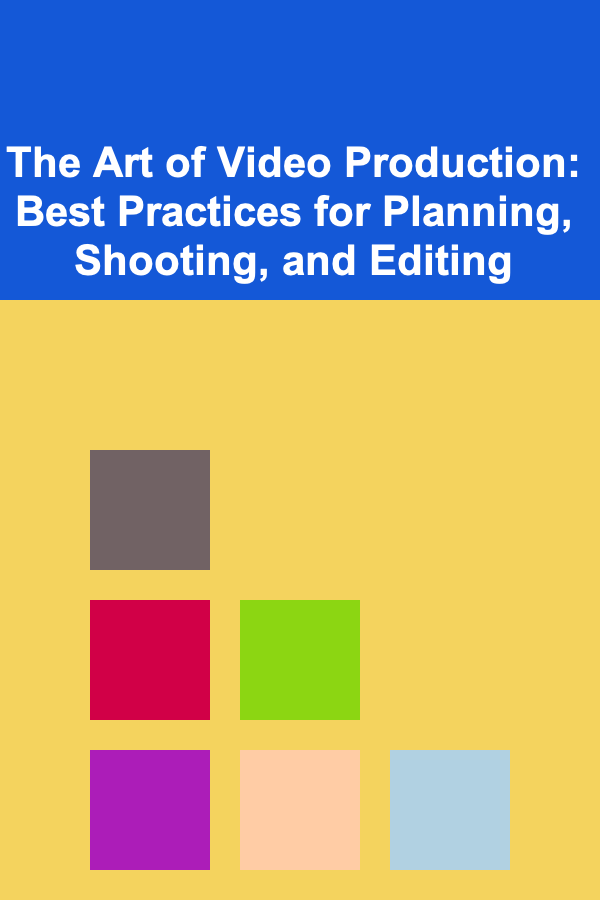
The Art of Video Production: Best Practices for Planning, Shooting, and Editing
ebook include PDF & Audio bundle (Micro Guide)
$12.99$6.99
Limited Time Offer! Order within the next:

Video production is an art form that demands creativity, technical proficiency, and meticulous attention to detail. Whether you're working on a short film, a corporate video, or a social media advertisement, the process involves multiple stages, each contributing to the final result. Understanding the best practices in video production can significantly enhance the quality of your work. This guide will explore actionable strategies for the three key stages of video production: planning, shooting, and editing.
Planning: Laying the Foundation for Success
The planning phase is the backbone of any successful video project. It involves outlining the objectives, developing a concept, organizing resources, and preparing for the shoot. A strong foundation in planning helps avoid unnecessary complications during the shooting and editing phases.
1.1 Define Your Purpose and Audience
Before diving into the creative process, it's important to clarify the purpose of your video. Are you creating a promotional video for a brand, a tutorial, or an entertaining short film? The objective will shape the tone, pacing, and style of your video. Additionally, understanding your target audience is essential in crafting content that resonates with them.
Actionable Tips:
- Clarify Your Objective: Whether it's to inform, entertain, or persuade, define the core message early on.
- Research Your Audience: Understand their preferences, behaviors, and pain points to ensure your video is engaging and relevant.
1.2 Create a Detailed Script or Outline
A script or outline is a roadmap for your video. It serves as a guide for what will happen in each scene, including dialogue, visual elements, and transitions. The script helps everyone involved in the production, from the director to the talent, stay on the same page.
Actionable Tips:
- Start with a Storyboard: Visualizing your video through sketches or shot lists will help communicate the vision clearly and guide the shooting process.
- Focus on Pacing: Keep your audience's attention by balancing slower, emotional moments with faster-paced sequences. Ensure each scene transitions smoothly into the next.
- Write with Precision: Avoid overly verbose scripts. Keep dialogue concise, and ensure every word or action serves the story.
1.3 Organize Resources and Budget
The planning stage also involves organizing resources such as equipment, locations, and talent. Budgeting is crucial to ensure that you don't run out of resources mid-project. Assess the costs of gear, crew, talent, location fees, and post-production work. Having a well-defined budget and timeline will help you stay within your limits.
Actionable Tips:
- Create a Realistic Budget: Break down costs into categories like equipment, location, crew, and post-production. Factor in unexpected expenses.
- Allocate Time Wisely: Create a shooting schedule that takes into account not only the time for shooting but also setup, breakdown, and travel.
1.4 Assemble the Right Team
Whether it's a small indie project or a large commercial, having the right team is vital. You may need a director, cinematographer, sound engineer, lighting techs, editors, and production assistants. Select team members based on experience, but also ensure they are collaborative and adaptable.
Actionable Tips:
- Hire for Skill, Not Just Availability: Look for team members who have proven experience and share a passion for the project.
- Foster Clear Communication: Make sure everyone understands the project's goals and their roles in achieving them. Miscommunication can lead to wasted time and resources.
Shooting: Bringing Your Vision to Life
Once the planning is complete, it's time to head to the set. The shooting phase is where the magic happens, as the scenes you've envisioned in pre-production are captured on film or video. The process requires not only technical know-how but also the ability to work efficiently with your crew.
2.1 Set the Scene: Lighting, Sound, and Camera Setup
The key to great visuals lies in lighting. The way you light a scene can completely change its mood and impact. Make sure that the lighting aligns with the tone of the video. Use soft lighting for calm, emotional scenes, and harsher lighting for intense, dramatic moments.
Sound is just as important as visuals. Clear dialogue and high-quality sound effects elevate a video and make it feel polished. Properly place microphones and use boom poles or lapel mics when necessary to capture clean audio.
The camera setup is another critical component. The choice of lens, framing, and camera movements must all support the story and enhance the viewer's experience.
Actionable Tips:
- Master the Three-Point Lighting Setup: This is the basic lighting technique that uses a key light, fill light, and back light to create a well-lit scene with depth.
- Test the Audio: Before shooting, test the sound levels. Wind, traffic, or background noise can interfere with clean audio. Use a windscreen for outdoor shoots and consider using soundproof rooms when possible.
- Plan Your Camera Angles: Experiment with different angles and focal lengths. Wide shots can show context, while close-ups create intimacy with the subject.
2.2 Keep it Moving: Camera Movements and Blocking
The way you move the camera can dramatically affect the energy and flow of the video. Whether you're using a dolly, handheld camera, or steady-cam, each movement should serve a purpose. Consider the pacing of the scene and the emotional tone you want to convey.
Blocking, or the positioning of actors within a frame, is also crucial. Well-planned blocking ensures that the action is engaging and easy to follow. It also keeps the focus on the most important parts of the scene.
Actionable Tips:
- Use Camera Movements Sparingly: Too much movement can distract from the story. Use smooth, purposeful movements like pans, tilts, or tracking shots to emphasize key moments.
- Plan Blocking for Engagement: Ensure that actors interact with the environment and each other in ways that feel natural and cinematic. Avoid static, unnatural poses unless stylistically appropriate.
2.3 Monitor Continuity and Coverage
Continuity is essential for creating a seamless narrative. Keep track of props, costumes, lighting, and actor positions to ensure that every shot matches the previous one. This is especially important when shooting over multiple days or locations.
Coverage refers to the number of shots taken for a single scene. Having multiple angles or variations of a scene gives you more options during editing and allows you to craft the most engaging sequence.
Actionable Tips:
- Take Reference Photos: These will help you match lighting, camera positions, and other elements when shooting the same scene across multiple days.
- Capture Overhead and Close-Up Shots: Filming both wide shots and close-ups will give you the flexibility to adjust the pacing and emotional impact of the scene during the edit.
Editing: Crafting the Final Story
Editing is where your video truly comes to life. It's not just about cutting out bad takes but about shaping the story, rhythm, and flow to create a compelling narrative. In this phase, you'll also enhance the visuals with color grading, sound design, and special effects.
3.1 Assemble Your Rough Cut
The first step in editing is to assemble a rough cut. This involves reviewing all of the footage, selecting the best takes, and placing them in the timeline in sequence. The goal here is to create a rough version of the video that follows the script or outline.
Actionable Tips:
- Start with a Story-First Approach: Focus on creating the structure of the story before fine-tuning the details like sound and effects.
- Avoid Perfectionism Early On: In the rough cut, don't worry about perfect transitions, color grading, or effects. Focus on the flow of the story first.
3.2 Refine with Transitions, Sound, and Effects
Once you have your rough cut, the next step is to refine it. This includes adding transitions between scenes, smoothing over any pacing issues, and ensuring the overall narrative flows. You should also start integrating sound effects, music, and voiceovers.
Actionable Tips:
- Use Music to Set the Tone: The right soundtrack can make a huge difference in the emotional impact of a scene. Choose music that aligns with the video's tone and pace.
- Be Cautious with Effects: While visual effects can be impressive, overuse can detract from the story. Use them sparingly and ensure they enhance the viewer's experience.
3.3 Final Touches: Color Grading and Sound Design
Color grading is an essential step in creating the visual tone of your video. It involves adjusting the color, contrast, and brightness to give the footage a more polished, professional look. Depending on your video's style, you may opt for a high-contrast look, muted colors, or a more natural aesthetic.
Sound design is just as important. Clean up dialogue, add background noise, and fine-tune the audio mix. Ensure that the levels of dialogue, music, and sound effects are balanced and cohesive.
Actionable Tips:
- Enhance Mood with Color Grading: Adjust colors to match the emotional tone of the video. Use cooler tones for somber moments and warmer tones for happy, uplifting scenes.
- Fine-Tune Audio: Balance the levels so that dialogue is always clear. Use equalization (EQ) to adjust frequencies and create a richer sound.
Conclusion
Video production is an intricate blend of art and technique, requiring skill in planning, shooting, and editing. Each stage demands careful thought and attention to detail. By following best practices in each phase, you can ensure that your video not only looks great but also tells a compelling story that resonates with your audience. Whether you're a beginner or an experienced filmmaker, these strategies will help you streamline the production process and produce high-quality videos that captivate and engage.
Reading More From Our Other Websites
- [Biking 101] Road Bike vs. Mountain Bike: Which One is Right for You?
- [Home Renovating 101] How to Plan Your Dream Home Renovation Ideas from Start to Finish
- [Home Storage Solution 101] How to Organize Pet Supplies with Storage Solutions That Work
- [Home Space Saving 101] How to Create Hidden Storage Under Your Stairs
- [Personal Care Tips 101] How to Pick a Body Wash with the Best Ingredients for Your Skin
- [Simple Life Tip 101] Best Simple‑Life Meditation Practices for Beginners with a Busy Schedule
- [Personal Care Tips 101] How to Incorporate Cuticle Oil Into Your Nail Care Routine for Better Results
- [Weaving Tip 101] From Thread to Tapestry: Beginner's Guide to Hand Weaving Techniques
- [Home Security 101] How to Make Your Home Less of a Target with Simple Security Hacks
- [Survival Kit 101] Survival Kit: Essential Items for Every Emergency Situation

How to Create a Time Management Checklist for Time Blocking
Read More
How to Keep Your Basement Dry and Prevent Water Damage
Read More
How to Reduce Acid Reflux with Diet
Read More
How to Simplify Your Digital Life
Read More
How to Teach Kids About Gardening with a Family Garden Project
Read More
How to Manage Sports Performance Anxiety
Read MoreOther Products

How to Create a Time Management Checklist for Time Blocking
Read More
How to Keep Your Basement Dry and Prevent Water Damage
Read More
How to Reduce Acid Reflux with Diet
Read More
How to Simplify Your Digital Life
Read More
How to Teach Kids About Gardening with a Family Garden Project
Read More